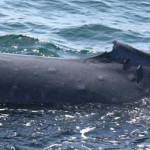
This is Science Weekend. Any thing you read here should be interpreted within the context of picnics, cartoons, and sushi dinners. The last five days of Science Week featured stories from colleagues contemplating important stuff like sea cucumbers, sediment transport, and blue smokers. It went well. It’s good to have new writers. We need more.
To be honest, the “Science Week” challenge caught me off guard. Deep Sea News always writes about science. We never drag on about ourselves. Craig and I are invertebrate biologists interested in the physical and evolutionary processes that maintain deep-sea biodiversity. It’s like saying “Let’s have Overdrive Week,” at Hot Rod Magazine. We barely have time to consider anything but sea spiders, squids, giant isopods, and bubblegum corals. Still, that won’t stop either us from telling you about deep-sea fish.
Deep-sea cod (family Gadidae) are “one of the most important families of fishes in the deep-sea”. Their deep siblings include pollock and hake. Pollock is used to make fake crab legs in the Subway seafood salad. It’s packaged as a strange white Asian boloney caled sarimi. Sarimi fishermen catch pollock with bottom trawls off Alaska, and press the meat into a white pressed sausage stained with bright colors in the sliced meat section at the Vietnamese grocery. Check it out sometime.
Cod fish have been getting a lot of attention in the media because they supposedly harbor the source of a new cure for cancer. This diagnosis is a reprieve, in a way. Cod fish also dominate the global fisheries statistics, accounting for somewhere near 90% of the global fisheries catch. They’re obviously delicious. It’s like a crime. Hear the death bells toll.
Cod already suffered commercial extinction in the North Atlantic, for example. There’s a book about it (called “Cod”) showing that historical abundance of cod explains early European migrations, and these migrations are closely tied to cod’s demise. Apparently, there is an inverse relationship in marine fisheries between tastiness and survivorship.
Unfortunately, science won’t stop people from driving these species to extinction. Culture might, though. I’ve heard the most recent large scale recovery of groundfish stocks (like cod) occurred in the North Pacific during World War II, when war stemmed the decline of some fish populations because fisheries were restricted. It is ironic that the best chance for cod fish to survive is if they yield the cure for cancer, or a war breaks out.
to be continued tomorrow…





You really ought to investigate these subjects before you write about them. It’s called SURIMI not sarimi and surimi is only one of the raw materials that go into making analog seafood products such as faux crab legs. Surimi is the minced and washed muscle proteins of fish that have been stabilized with cryoprotectants such as sugars. Harvesters do not make analog food products, rather surimi is the cost effective raw material allowing this high-quality protein to be transported to analog manufacturers – based far from the Bering Sea – while preserving its healthful qualities.
Your obvious disdain for surimi analog products is grounded in ignorance and seems culturally biased. A number of Asian surimi products are truely remarkable. They are as different from the discount warehouse foods you encountered as European pat
I worked for a while at a local surimi factory that supplies Subway, among other restaurants. The production process was fascinating, and standards of purity and hygiene were far more strictly adhered to — by workers at every level — than they were at the local organic-granola factory where I’ve also worked. You may not care for the taste or texture of surimi you’ve eaten in seafood salads in the US, but it’s a far cry from “boloney (sic).”
I cannot believe we are even having this dialogue. I fully support Peter’s sentiment. You have to wonder about foods in which we use terms like “analog”, “stabilized with cryoprotectants”, and “cost effective raw material”. It has nothing to due with cultural bias as I reguraly enjoy cuisine far from Arkansas roots. I am equally afraid of all products that are processed and far removed from thier original state.
Oops. Don’t get me wrong. I like baloney. That was actually a complement. I also like surimi, and Subway seafood salad sandwiches. Did I say otherwise? I’ll try and get to the point tomorrow.
Sorry for the misspelling, Dr. Smiley. No offense.
Peter means to say baloney is a “compliment”.
Wow, did someone tip off the surimi industry.
Must one have? I have no current connection with it; I temped in a factory for some extra spending money for a while. I don’t know Dr. Smiley, but the reason I watch this blog (and have been for several months) is that I studied marine affairs at the University of Washington in the ’90s and am still interested in fish and the oceans.
JEBCIE SIE CHUJE PIERDOLONEEEE!